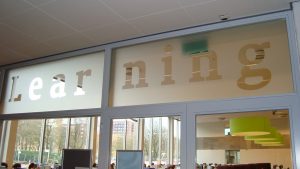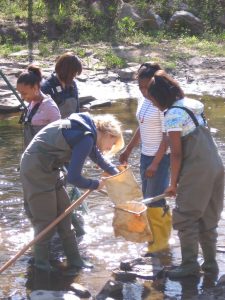
“learning zone” by biblioteekje is licensed under CC BY-NC-SA 2.0
I entered into my Masters program with the intent of enriching my pedagogical practices for the implementation of an Environmental Science 11 class in the spring of 2020. This class will provide an opportunity for learners to participate in authentic inquiry based projects in collaboration with community mentors. I knew I would need to expand my skillset in order to
- communicate effectively with students using technology
- assist with project organization
- model and facilitate effective collaborative relationships with community members
- assess authentic displays of student learning.
It often feels daunting to embark on such a non-traditional learning experience within the confines of the public school structure, however I have been encouraged and inspired by a recent article I read by Pei-Ling Hsu and Laura Venegas. Activity Features of High School Students’ Science Learning in an Open-Inquiry-Based Internship Programme has offered valuable insight and resources for the planning of Environment Science 11, and reminds me that impactful learning can take place when students are able to collaborate with experts to conduct projects that are inspired by their own interests and curiosity .
Hsu and Venegas outline the development of activity theory, which has had three important stages in its development. First, cultural-historical activity theory (CHAT)
explains how human activities function in the world and how individuals make meaning through ‘social, cultural, educational and historical contexts’ (Postholm, 2015, p.45)
CHAT focused primarily on the learning that occurs when an individual interacts with artifacts. A subsequent activity theory took into account the context of collective activity. For my intents and purposes I will focus on collective activity between students, teacher, teacher assistants and community mentors. The most recent amendment to activity theory considers the interactions between collaborators and seven key variables that allow the learner to make meaning of the context around them. The seven key variables, features or constructs of the activity are:
- Tools: instruments that support and facilitate the activity
- Subject: individuals, students, groups, or organisations
- Rules: the guidlines which establish normative behaviours
- Community: the group or individuals interacting between the object and the subject
- Division of labour: how the work is divided within the community
- Object: the ‘target’ which is altered into outcomes, ie. curriculum
- Outcome: the result of the activity system
These key variables have initiated considerable reflection for me with regards to my upcoming Environmental Science class.
Overview of Research
In the study, 36 high school students worked alongside university scientists over 40 classes that spanned across a seven month internship program. Students were invited to discuss and reflect on project design, data collection, and challenges in their investigations and were required to present their scientific research to their families, teachers, and friends. Journal reflections, video-recordings, scientific presentations, interviews and field notes were analyzed over the seven month period and participant perception of the seven key variables were as follows:
- Tools: 73% reported that students were equipped with advanced scientific equipment, hands-on teaching methods, and communication tools to learn science
- Subject: 86% reported that students were competent, autonomous and perseverant learners
- Rules: 47% reported that students followed safety rules, ethics, and communication to practice science
- Community: 65% reported that the internship community was supportive, encouraging, and responsive to students’ needs
- Division of labour: 45% reported that students developed skills to work on projects collaboratively with others
- Object: 73% reported that students were learning scientific knowledge that was in-depth, specific and applied to real-life situations
- Outcome: 27%reported that students were able to present their scientific findings and exchange ideas with other community members
Personal and Professional Application of the Research
One of my favorite Ted Talks is given by Rita Pierson. Rita has been teaching for 40 years and comes from a long line of educators, and she expresses the impact of connection and relationships on learning.
Rita claims that significant learning can not happen without significant relationships. It might follow that collaborative relationships with others has the potential to be a powerful teaching and learning tool. In Environmental Science 11 students will experience hands-on learning with community mentors, while engaging in inquiry-based group projects that directly impact their local environment. In order to ensure positive and productive learning experiences for students, I will need to facilitate positive and productive collaboration between students, teacher, teacher assistants, and community mentors. Hence, my research topic is collaboration, and two potential inquiry questions for my masters project are:
“How can I support productive collaboration with community mentors in Environmental Science 11?” and
“How will I determine if a community mentoring experience was successful?”
Hsu and Venegas’ research and their seven key variables bring forth several questions when it comes to facilitating effective collaborative experiences:
- What method(s) of communication can we employ to ensure that teacher, student(s) and community members work as a team?
- How can I encourage autonomy and perseverence in my students?
- How can I ensure that safety and ethics are in place when students are collaborating with community members
- How can I ensure that community members are supportive, encouraging, and responsive to students’ needs?
- What collaborative skills are necessary and how will I teach them?
- How can I support students in the production and presentation of their learning?
Two strategies I can put in place that may begin to respond to the above noted questions are
- Prepare a document with students that can be reviewed at an initial team meeting. This document will include a place where team members can agree upon the preferred method of communication, outline the expectations for the teacher, student, and community member, and discuss how team members might navigate unexpected challenges or obstacles.
- Be approachable and available to students and community mentors throughout project development both in person and via technology.
More questions remain than answers when I consider the implementation of community mentoring and collaborative inquiry. How will students prefer to communicate with me, with each other and with the mentor? Will community mentors be available during our scheduled class time for collaborating? How will I manage being available to 6 or 7 groups of students during project development and implementation? What will my collaboration with mentors look like? What safeguards can be implemented to ensure positive experiences with community mentors? How can the seven key variables further inform my teaching and assessment practices? This list is by no means exhaustive, however I am so encouraged and excited by the possibilities of authentic scientific learning in collaboration with local experts that I believe my efforts will be worthwhile.

“Macroinvertebrate Sampling” by James River Association is licensed under CC BY-NC 2.0
Related References
The reference list for Hsu and Venegas’ article is a valuable source of information regarding inquiry, authentic science curriculum, activity theory, public engagement, valid and meaningful assessment, nature in science, and research apprenticeships.
A search of Dr. Gilbert Onwu, of the University of Pretoria reveals a variety of research projects relevant to environmental education, indigenous knowledge systems and science education, and outcomes-based education.
Dr. Gillian Judson, @perfinker, is an author, blogger (educationthatinspires.ca), professor, and Executive Director of the Centre for Imagination in Research, Culture and Education at SFU. Her research interests include (but are not limited to) online learning, educational change, leadership, and sustainability, inquiry-based learning.
RT Johnson and DW Johnson have numerous publications in the area of cooperative learning.
I stumbled upon Dr. Robert Slavin’s blog at robertslavinsblog.wordpress.com. Dr. Slavin is the Director of Hopkins Center for Research & Reform in Education in Baltimore. His twitter account is @RobertSlavin.
Allyson Hadwin (@AllysonHadwin) is an Associate Professor and TIE lab co-director at UVIC. Her areas of focus include (but are not limited to) self-regulation, collaborative learning, and 21st century learning strategies. Dr. Hadwin’s research site (allysonhadwin.wordpress.com) include numerous publications on the above noted areas of focus.
And of course, @hopkinsjeff, @trev_mackenzie, @ChristineYH and @courosa whom we have had the pleasure of meeting in EDCI 568.
Additional relevant twitter feeds include @TrevorMuir and @spencerideas
Cooperation versus collaboration. pic.twitter.com/ytIaoJaxpK
— John Spencer (@spencerideas) July 22, 2019
Project Based Learning doesn’t replace effective teaching practices, it gives purpose and authenticity to them. https://t.co/wbu2ErE6UB
— Trevor Muir (@TrevorMuir) July 18, 2019